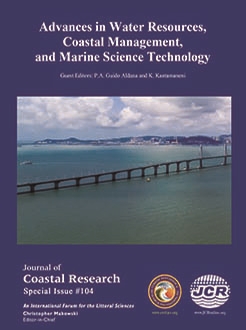Wang, M.; Sang, S.Z.; Ma, Z.Y.; Kang, Z.; Zhang, Y.P.; Li, W.M.; Chen, B.; Cheng, J.Y., and Wei, P., 2020. Predicting diagenetic facies in a tight sandstone reservoir using robust regression analysis. In: Guido Aldana, P.A. and Kantamaneni, K. (eds.), Advances in Water Resources, Coastal Management, and Marine Science Technology. Journal of Coastal Research, Special Issue No. 104, pp. 761–767. Coconut Creek (Florida), ISSN 0749-0208.
Globally, most reservoirs of tight sandstone oil presently have low porosity, low permeability, and high pore structure heterogeneity. These characteristics complicate the study of reservoir prediction and seepage law. Taking the Chang 8 reservoir in Longdong Area, Ordos Basin as an example, this study analyzed the micro composition, diagenesis, pore structure, and other characteristics of sandstone through a physical property test and casting thin section observation. The sandstone was divided into four diagenetic facies: primary pore strongly developed facies, chloride concentration primary porosity developed facies, solution facies, and strongly dense facies. The characteristics of different diagenetic facies were quantitatively evaluated using the following parameters: approximate compacting rate, approximate cementing rate, approximate dissolution rate, micro porosity ratio, and diagenetic coefficients. Based on the results of robust regression analysis, a new prediction method of porosity-permeability-diagenetic coefficient is proposed. The correlation coefficient between the results of the actual measurement and the model fitting was 0.7105, which indicates that the model is highly accurate. The prediction results of diagenetic facies distribution show that high-quality reservoirs are mainly developed at the top and bottom of the distributary channel and mouth bar sand body, and the sand body in the middle of partial distributary channel also has the potential to form reservoir. This method provides a new technical scheme for the prediction of tight sandstone reservoirs.





